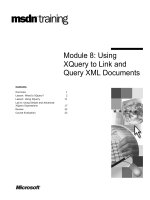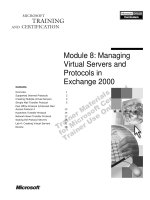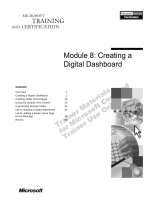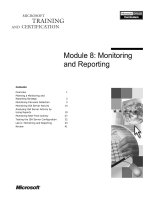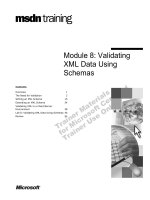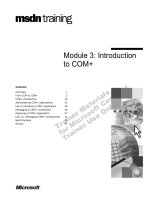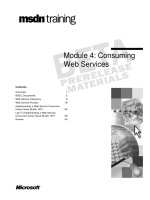Tài liệu Module 8: Querying Full-Text Indexes pdf
Bạn đang xem bản rút gọn của tài liệu. Xem và tải ngay bản đầy đủ của tài liệu tại đây (834.07 KB, 26 trang )
Contents
Overview 1
Introduction to Microsoft Search Service 2
Microsoft Search Service Components 3
Getting Information About
Full-Text Indexes 5
Writing Full-Text Queries 7
Recommended Practices 14
Lab A: Querying Full-Text Indexes 15
Review 21
Module 8: Querying
Full-Text Indexes
Information in this document is subject to change without notice. The names of companies,
products, people, characters, and/or data mentioned herein are fictitious and are in no way intended
to represent any real individual, company, product, or event, unless otherwise noted. Complying
with all applicable copyright laws is the responsibility of the user. No part of this document may
be reproduced or transmitted in any form or by any means, electronic or mechanical, for any
purpose, without the express written permission of Microsoft Corporation. If, however, your only
means of access is electronic, permission to print one copy is hereby granted.
Microsoft may have patents, patent applications, trademarks, copyrights, or other intellectual
property rights covering subject matter in this document. Except as expressly provided in any
written license agreement from Microsoft, the furnishing of this document does not give you any
license to these patents, trademarks, copyrights, or other intellectual property.
2000 Microsoft Corporation. All rights reserved.
Microsoft, BackOffice, MS-DOS, PowerPoint, Visual Studio, Windows, Windows Media, and
Windows NT are either registered trademarks or trademarks of Microsoft Corporation in the
U.S.A. and/or other countries.
The names of companies, products, people, characters, and/or data mentioned herein are fictitious
and are in no way intended to represent any real individual, company, product, or event, unless
otherwise noted.
Other product and company names mentioned herein may be the trademarks of their respective
owners.
Project Lead: Cheryl Hoople
Instructional Designer: Cheryl Hoople
Technical Lead: LeRoy Tuttle
Program Manager: LeRoy Tuttle
Graphic Artist: Kimberly Jackson (Independent Contractor)
Editing Manager: Lynette Skinner
Editor: Wendy Cleary
Editorial Contributor: Elizabeth Reese
Copy Editor: Bill Jones (S&T Consulting)
Production Manager: Miracle Davis
Production Coordinator: Jenny Boe
Production Tools Specialist: Julie Challenger
Production Support: Lori Walker (S&T Consulting)
Test Manager: Sid Benavente
Courseware Testing: Testing Testing 123
Classroom Automation: Lorrin Smith-Bates
Creative Director, Media/Sim Services: David Mahlmann
Web Development Lead: Lisa Pease
CD Build Specialist: Julie Challenger
Online Support: David Myka (S&T Consulting)
Localization Manager: Rick Terek
Operations Coordinator: John Williams
Manufacturing Support: Laura King; Kathy Hershey
Lead Product Manager, Release Management: Bo Galford
Lead Product Manager: Margo Crandall
Group Manager, Courseware Infrastructure: David Bramble
Group Product Manager, Content Development: Dean Murray
General Manager: Robert Stewart
Module 8: Querying Full-Text Indexes iii
Instructor Notes
This module describes the Microsoft
®
Search service, how to access
information about indexes on text fields, and how to query those full-text
indexes. By the end of the module, students should be familiar with the
capabilities of this service, but not expert in its use. At the end of this module,
the student will be able to:
!
Describe Microsoft Search service function and components.
!
Get information about full-text indexes.
!
Write full-text queries.
Materials and Preparation
Materials
To teach this module, you need the following materials:
!
Microsoft PowerPoint
®
file 2017A_08.ppt.
!
The C:\Moc\2071A\Demo\Ex_08.sql example file contains all of the
example scripts from the module, unless otherwise noted in the module.
Preparation
To prepare for this module, you should:
!
Read all of the materials.
!
Complete the lab.
Presentation:
45 Minutes
Lab:
60 Minutes
iv Module 8: Querying Full-Text Indexes
Module Strategy
Use the following strategy to present this module:
!
Introduction to Microsoft Search Service
Describe the concept and role of the Microsoft Search service in relation to
Microsoft SQL Server
™
2000. Discuss the advantages of using the
Microsoft Search service to index and query database tables in SQL Server.
!
Microsoft Search Service Components
Describe the objects that the Microsoft Search service uses to implement
full-text searching: full-text index and full-text catalog.
!
Getting Information About Full-Text Indexes
Describe the various methods and information that you can use to gather
information about full-text search by using full-text system stored
procedures, Transact-SQL functions, and SQL Server Enterprise Manager.
You can retrieve metadata and status information for each level—database,
catalog, table, and column.
!
Writing Full-Text Queries
Discuss how to write full-text queries by using Transact-SQL statements
such as the CONTAINS and FREETEXT predicates and the
CONSTAINSTABLE and FREETEXTTABLE functions. Point out when to
use the predicates rather than the functions.
Customization Information
This section identifies the lab setup requirements for a module and the
configuration changes that occur on student computers during the labs. This
information is provided to assist you in replicating or customizing
Microsoft Official Curriculum (MOC) courseware.
The lab in this module is dependent on the classroom configuration
that is specified in the Customization Information section at the end of the
Classroom Setup Guide for course 2071A, Querying Microsoft SQL Server
2000 with Transact-SQL.
Lab Setup
There are no lab setup requirements that affect replication or customization.
Lab Results
There are no configuration changes on student computers that affect replication
or customization.
Importan
t
Module 8: Querying Full-Text Indexes 1
Overview
!
Introduction to Microsoft Search Service
!
Microsoft Search Service Components
!
Getting Information About Full-Text Indexes
!
Writing Full-Text Queries
You can issue full-text queries against plain-text data in tables in Microsoft
®
SQL Server
™
2000, including words, phrases, and multiple forms of a word or
phrase. You implement the full-text search capability in SQL Server by using
Microsoft Search service.
At the end of this module, the student will be able to:
!
Describe Microsoft Search service function and components.
!
Get information about full-text indexes.
!
Write full-text queries.
Slide Objective
To provide an overview of
the module topics and
objectives.
Lead-in
In this module, you will learn
about Microsoft Search
service and how to query
full-text indexes.
2 Module 8: Querying Full-Text Indexes
Introduction to Microsoft Search Service
!
Provides Text-based Searches in SQL Server
#
Complex searches on unstructured text data for words
and phrases
#
More powerful than LIKE operator and wildcards
!
Available in Other Microsoft Products
#
Indexing Service, Exchange 2000, Commerce Server
With Microsoft Search service, you now can query character-based data in
tables by using full-text search. A full-text query searches for words, phrases, or
multiple forms of a word or phrase in the character-based columns (char,
varchar, text, ntext, nchar, or nvarchar).
Provides Text-based Searches in SQL Server 2000
SQL Server has always had the capability to retrieve text, based on pattern
matching using the LIKE operator and wildcards.
Now, by using Microsoft Search service, you can create more complex
searches. With a full-text query, you can perform a linguistic search of
character data in tables. A linguistic search operates on words and phrases,
allowing you to search for similar words or phrases and different forms of a
word, or to target words that approximate one another.
Available in Other Microsoft Products
Microsoft Search service is also included with these products:
!
Microsoft Indexing Service
!
Microsoft Exchange 2000
!
Microsoft Commerce Server
Slide Objective
To describe the concept of
Microsoft Search service in
relation to SQL Server.
Lead-in
With Microsoft Search
service, you now can query
character-based data
in tables by using
full-text search.
Module 8: Querying Full-Text Indexes 3
Microsoft Search Service Components
!
Search Service Structures
#
Full-text index
Keeps track of significant words used in a table
Requires unique key column or primary key
#
Full-text catalog
Is a collection of full-text indexes
!
Microsoft Search Service Functions
#
Indexing
#
Querying
Microsoft Search service stores information about full-text data in structures
outside of SQL Server.
Search Service Structures
SQL Server uses two structures to track columns that are full-text search
enabled. These structures are used to communicate with Microsoft Search
service for building indexes and processing queries.
Microsoft Search service uses two structures to implement full-text searching:
full-text index and full-text catalog.
Full-Text Index
A full-text index is an index that keeps track of the significant words used in a
table and where they are located. This index structure supports an efficient
search for all items containing indexed words, and advanced search operations
such as phrase searches and proximity searches.
The principal design requirement for full-text indexing, querying, and
synchronization is the presence of a unique key column (or single-column
primary key) on all tables that are registered for full-text search.
Full-text indexes differ from SQL Server indexes, which are controlled
by the SQL Server database in which they are defined.
Slide Objective
To introduce the
components of full-text
search.
Lead-in
Microsoft Search service
stores information about full-
text data in structures
outside of SQL Server.
Note
4 Module 8: Querying Full-Text Indexes
Full-Text Catalog
The full-text catalog is the location where full-text indexes reside. This is an
NTFS file system directory that is accessible only by Microsoft Windows NT
®
Administrator and Microsoft Search service. The full-text indexes are organized
into full-text catalogs. Typically, the full-text index data for an entire database
is placed into a single full-text catalog. However, administrators have the
flexibility to partition the full-text index data for a database across more than
one full-text catalog. This is particularly useful if one or more of the tables
being full-text indexed contains a large number of rows.
Search Service Functions
Microsoft Search service has two primary functions: building and maintaining
full-text indexes, and using the indexes to process queries.
Indexing
Microsoft Search service builds and maintains full-text indexes for tables set up
for full-text indexing. It goes through the rows of the table and extracts key
words from the columns specified for full-text searching. These values are
stored in operating system files and are organized into full-text catalogs. A table
must have a unique index defined on it in order for you to build a full-text index
on it.
Querying
Microsoft Search service processes full-text search queries. It determines which
entries in the index meet the full-text selection criteria. For each entry that
meets the selection criteria, it returns the identity of the row plus a ranking
value to the SQL Server service, where this information is used to construct the
query result set.
When processing a full-text query, the search engine returns to SQL Server the
key values of the rows that match the search criteria.
Module 8: Querying Full-Text Indexes 5
Getting Information About Full-Text Indexes
!
Using System Stored Procedures
#
sp_help_fulltext_catalogs
#
sp_help_fulltext_tables
#
sp_help_fulltext_columns
!
Using Transact-SQL Functions
#
Use Transact-SQL functions to obtain information about
full-text properties
USE northwind
SELECT
DATABASEPROPERTY('Northwind','IsFullTextEnabled')
GO
USE northwind
SELECT
DATABASEPROPERTY('Northwind','IsFullTextEnabled')
GO
You can gather information about full-text search by using full-text system
stored procedures, Transact-SQL functions, and SQL Server Enterprise
Manager. You can retrieve metadata and status information for each level—
database, catalog, table, and column.
Using System Stored Procedures
You can use the full-text system stored procedures in the following table to
obtain information about full-text indexes.
Stored procedure Function
sp_help_fulltext_catalogs Returns the ID, name, root directory, status, and
number of full-text indexed tables for the specified
full-text catalog
sp_help_fulltext_tables Returns a list of tables that are enabled for
full-text indexing
sp_help_fullltext_columns Returns the columns that are enabled for
full-text indexing
Slide Objective
To describe how to
get information about full-
text search.
Lead-in
You can gather information
about full-text search.
6 Module 8: Querying Full-Text Indexes
Using Transact-SQL Functions
You also can use Transact-SQL functions to obtain the values of
full-text properties.
The following table lists frequently used property values that you can use to get
information about full-text search.
Function Property value Description of Property
COLUMNPROPERTY IsFullTextIndexed Indicates that a column is enabled for
full-text search
DATABASEPROPERTY IsFullTextEnabled Indicates that a database is enabled for
full-text search
INDEXPROPERTY IsFulltextKey Identifies the index used by Microsoft
Search service
OBJECTPROPERTY TableHasActiveFulltextIndex Indicates that a table is enabled for
full-text search
FULLTEXTCATALOGPROPERTY PopulateStatus Returns the in-process state of a
Microsoft Search catalog
ItemCount Returns the number of entries contained
in a Microsoft Search catalog
IndexSize Returns the size of the full-text index,
in megabytes
UniqueKeyCount Returns an approximate number of non-
noise words that are able to be uniquely
addressed in a Microsoft Search catalog
LogSize Returns the size of the last full-text
index, in megabytes
PopulateCompletionAge Returns the most recent date and time at
which an update was made to the
referenced Microsoft Search catalog
FULLTEXTSERVICEPROPERTY ResourceUsage Specifies a relative operating system
execution priority setting for the
Microsoft Search service
IsFullTextInstalled Indicates a successful installation on an
organization server running SQL Server
The IsFullTextEnabled property is also used to determine whether full-text
querying is enabled for the Northwind database.
USE northwind
SELECT DATABASEPROPERTY('Northwind', 'IsFullTextEnabled')
GO
If a value of 1 is returned, the Northwind database is enabled for full-text
querying. A value of 0 indicates that the Northwind database is not enabled for
full-text querying.
Example

